When Earth is a Graveyard of Gods: Edges by Linda Nagata
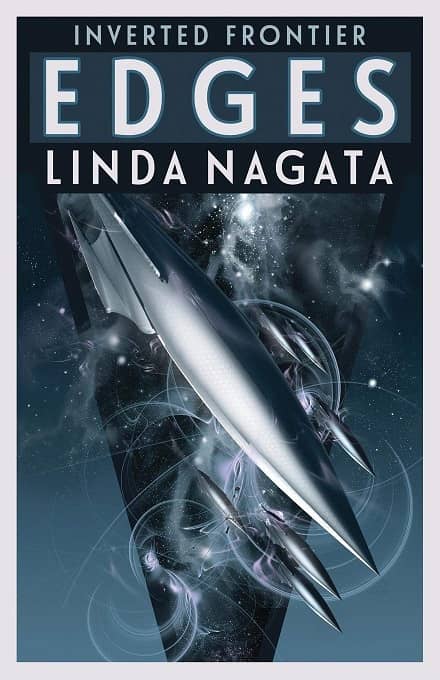 |
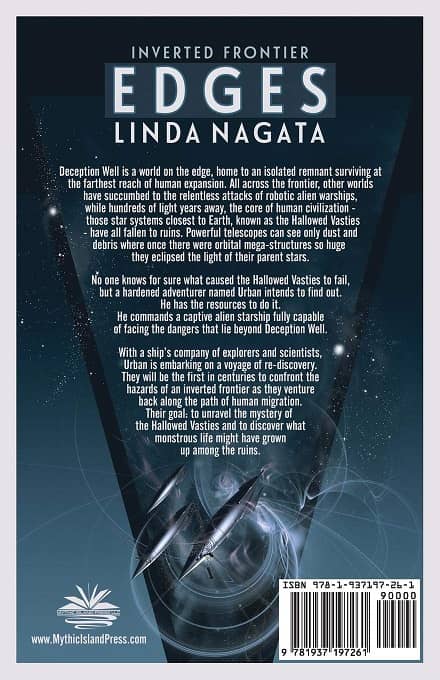 |
The Fermi Paradox is relatively simple. It asks, considering the immense expanse of time, the apparent plentitude of planets in our galaxy, and thus the likelihood of intelligent life somewhere else — why don’t we see it? Why is the sky so resolutely silent? Answering this question has become something of a hobby among science fiction writers, with responses ranging from the transcendental to the sobering. Maybe life evolves quickly beyond the physical. Or maybe life is out there but quietly watching and waiting. Linda Nagata’s work offers a more straightforward answer: intelligent life is hunted.
In Nagata’s universe, Chenzeme coursers are living alien weapons: biomechanical vessels coated in hulls of intelligent “philosopher cells.” The ships are programmed to systematically hunt down technological civilizations and sterilize entire worlds. In her previous series, humanity’s spread into the frontier was halted by encounters with these vessels. The coursers were only one prong though in an ancient assault that had long outlasted the ship’s original creators. The other was an ancient virus, which bypassed the frontier worlds and affected the original core planets of humanity’s origins, including Earth, subsuming entire planetary populations into huge group-minds that went on to construct immense Dyson spheres enclosing their stars.
I fell into this universe through a paperback copy of the final book in her previous series, Vast (1998), and was immediately entranced (I reviewed Vast for Black Gate here). Nagata has a way of making the incredible distances, both in space and time, of galactic travel real. Humans are tenuous here, following divergent evolutionary roads, clinging to disparate worlds in the night. Vast followed an expedition from the planet Deception Well to find the source of the Chenzeme coursers and spun out from there into a stunning novel that was at its core a centuries-long chase sequence but managed to explore the characters and the biomechanical and technological realities of life aboard the exploratory ship.
All this to say I was thrilled when I learned that Nagata, after nearly two decades, was returning to this universe with a follow-up series called Inverted Frontier. The first book in this series, Edges, was released this spring and Nagata was kind enough to send me a pre-print for review.
[Click the images for Vast versions.]
I felt, returning to this universe, like some of the characters in this story. The reality of interstellar flight in Nagata’s galaxy means the lives of characters are split between physical avatars (which can be created and destroyed at will) and disembodied intelligences, or ghosts. Avatars can sleep, and ghosts can edit their consciousnesses to alter their perception of time. On a thousand-year journey, then, different characters could pass a centuries-long trip as time skipped sleeping or time experienced awake. (They could also choose both, leaving a ghost awake for the journey and then re-integrating its memories with their own when their body awakened decades or centuries later.) In similar fashion, a reader who finished Vast when it was published twenty years ago has been waiting a long time for this continuation. I, having found it only last summer, skipped over those intervening years and experienced it as an immediate sequel.
In Edges, the survivors of the expedition that formed the storyline of Vast have returned to their home with tools to finally defeat the Chenzeme. Having captured a Chenzeme cruiser that he now commands, Urban wants to return to the worlds of humanity’s birth and understand the fate of the “Hallowed Vasties,” those Dyson structures created centuries ago and now fallen into ruin. This central mystery is essential to the flavor of wonder pervading the novel. Because such immense distances separate humanity, all the worlds on the frontier have been able to do is observe this riddle at telescopic distances as stars were cordoned off and then slowly reappeared. The Chenzeme threat meant travel between inhabited worlds was interdicted, and the inhabitants of Urban’s homeworld of Deception Well now fear they’re the only surviving humans anywhere. Urban’s return with the Chenzeme cruiser offers a handful of explorers a chance to probe this “inverted frontier” and find out what happened on Earth and the other core worlds of humanity.
The first third of Edges is rich with the complexities of making this expedition possible. Urban doesn’t want to slow down his passage toward the Hallowed Vasties, and so there is time for only a handful of passengers to send their intelligences aboard and join him. But the ship itself is an organism in an uneasy biomechanical alliance — a hybrid of Chenzeme tissue, human technology, and the utterly alien coral-like “reefs” nesting in the ship that make interstellar travel possible. Urban’s intelligence controls this delicate balance. An influx of passengers who want to instantiate as living avatars and the resources needed to grow a habitable space within the flesh of the ship become immediate problems.
 |
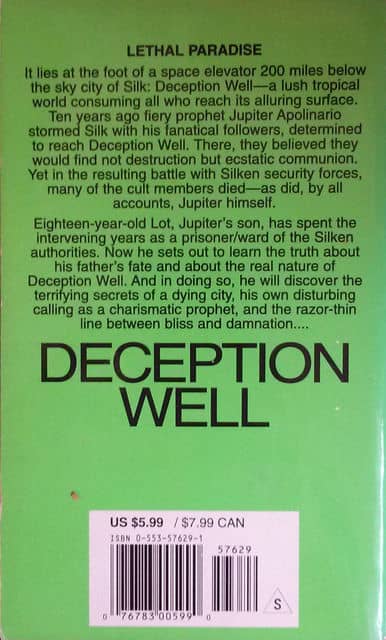 |
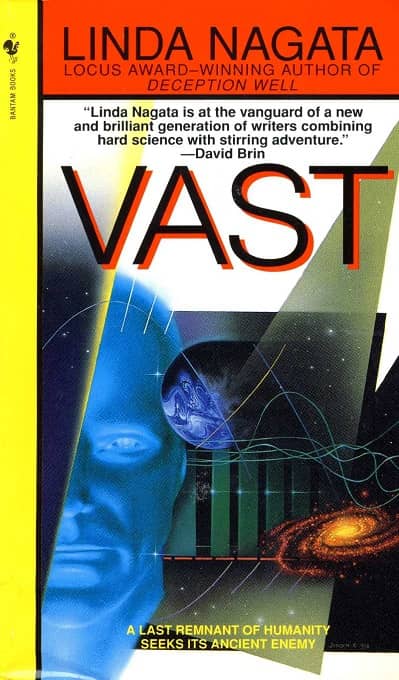 |
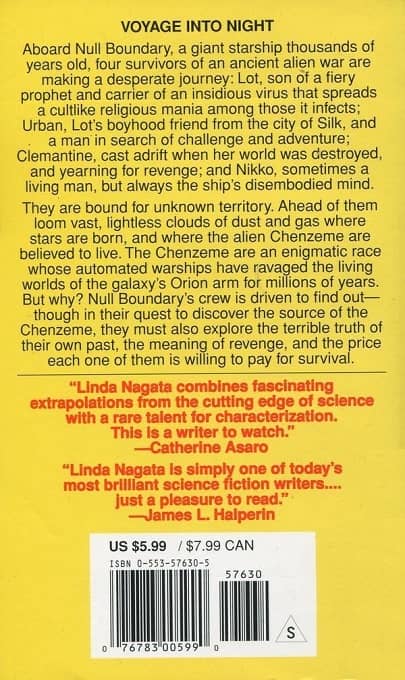 |
Deception Well (1997) and Vast (1998). Bantam Spectra editions; covers by Bruce Jensen
It would have been enough for this first book, I think, to have joined these characters on a voyage of discovery. The most interesting scenes, for instance, are those when the crew gathers each year for the updated telescope images their vessel is gathering as it approaches the star systems near Earth. The wonder from slowly resolving views of immense structures is heightened because they’re not of alien manufacture; the crewmembers (and readers) are trying to grapple with the scale that these other humans must have evolved and built. Urban’s ship is returning to humanity’s ancestral home but finding it a graveyard of gods.
But a long voyage of discovery probably wouldn’t have held all readers, so when it looked like Nagata might have opted for the novel’s major conflicts to come from the crewmembers themselves as they worked to balance and allocate the limited resources of the Chenzeme’s cruiser and live under Urban’s autocratic control, she introduces a super-villain-type character that provides a simpler conflict and a taste of what the explorers might encounter when they reach their destination. During a brief side excursion, Urban and another character inadvertently bring back to the ship an intelligent contamination, a metahuman consciousness immensely intelligent and arrogant. Marooned in space for some unknown reason, he attempts to hijack Urban’s ship as an avenue back to his original world.
Though this character, which comes to be called Lezuri, seems cut from familiar cloth (similar in some respects to Star Trek’s Q or other assorted technological godlings), Nagata’s biotech style means his infiltration of the ship is some of the most gripping prose of the work. Urban’s ship is more like a carefully balanced ecosystem or symbiotic organism, and Lezuri is an intelligent contagion, a virus working to establish a threshold and ultimately gain control, a parasite. Lezuri also becomes a fault-line along which the crew divides, torn between seeing him as a malevolent force to be eliminated or as a powerful ally.
Edges is the first installment of the Inverted Frontier series, and the book raises more questions than it answers. There is closure in the sense that the first round of the crew’s encounter with Lezuli wraps up. They’re able to regain control of the ship, though at a huge cost. Nagata’s skill with creating characters, including old favorites like Urban and Clementine, and representing their humanity even in the context of continual translation between disembodied intelligences, disposable avatars, and back again, remains as sharp as ever. Indeed, the way she handles these new modes of consciousness by making them feel real and everyday, is as strong as it has always been and lends a philosophical depth to the wonder that forms the backbone of her novels.
The engine that made her previous work so engaging, and that continues to drive this new chapter, is her sense of scale: human consciousness and experience suspended between immense distances of time and space. On the one hand this allows her to show human society and exploration spread across the night, but on the other hand she drills down to the cellular scale of the biotechnology that makes these ships and this exploration possible. All of this plays out again, effectively and remarkably well, in Nagata’s scifi return.
It’s great to be traveling with her again.
Stephen Case has published fiction at Beneath Ceaseless Skies, Orson Scott Card’s Intergalactic Medicine Show, and Daily Science Fiction. His reviews have appeared at Fiction Vortex and Strange Horizons, as well as his own blog, stephenreidcase.com. His last article for us was a review of Linda Nagata’s Vast.